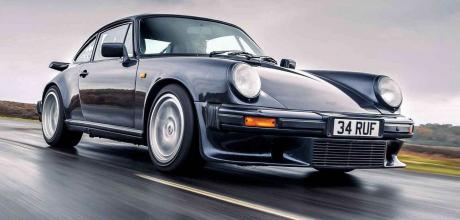1984 RUF BTR-1
In the chase to establish the first 200mph road car, this special Porsche laid some extremely impressive foundations. Meet RUF’s BTR-1.
Words Matthew Hayward
Photography Jonathan Fleetwood
FIRST RUF PORSCHE Long before the Yellowbird, a 186mph 911
FASTER THAN FAST
Very first of Alois Ruf's supercar-slaying 911 s
During the 1980s, the race to build the first production 200mph car was quite the spectacle. In 1987, Ferrari claimed that the F40 was first to tiptoe over the magic double-ton to 201mph — and that same year, a small German manufacturer called RUF turned up to Road & Track’s top speed shoot-out at the Ehra-Lessien track, using the 5.4-mile straight to achieve a top speed of 209mph with the CTR ‘Yellowbird’.
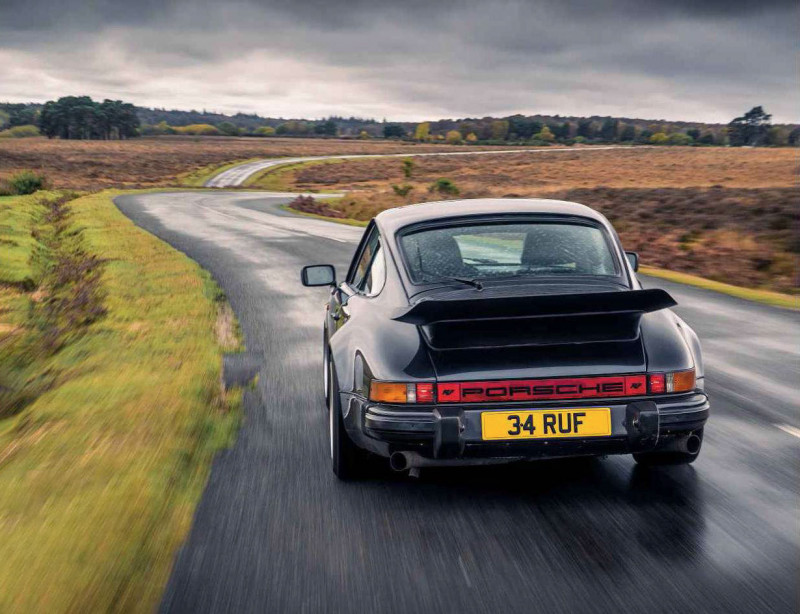
Thanks to this and the later Faszination on the Niirburgring promotional video, Yellowbird catapulted RUF to an international audience. But that wasn’t the beginning of the story. Although he was just starting out on his journey as a standalone manufacturer, Alois Ruf had been invited to participate in R&T’s first World’s Fastest Car test back in 1984. The dark blue RUF BTR you see here — chassis no.l — is the special car used to make that run.
IT’S A CAR OF IMMENSE PRESENCE RUT ALSO OF SURPRISING UNDERSTATEMENT’
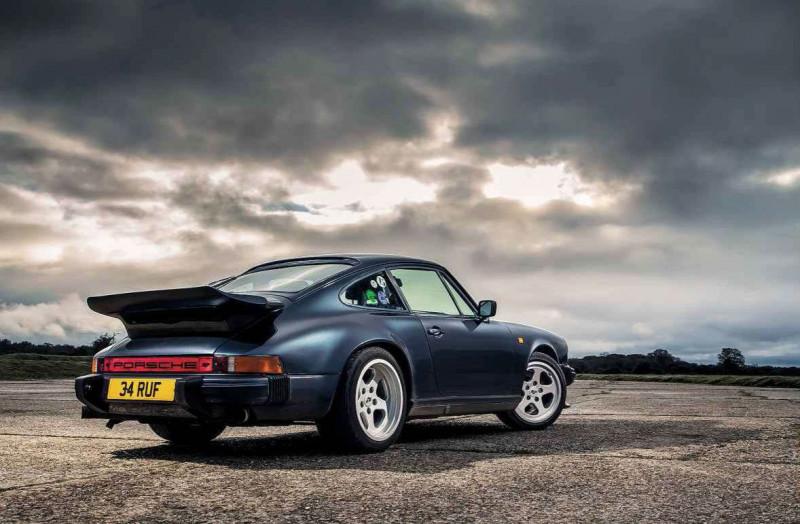
Driven by Phil Hill and Paul Frere at the same VW-owned test track, it achieved a verified top speed of 186.2mph — Frere managed a one-way 189mph by folding both door mirrors back — leaving the Ferrari BBi, Lamborghini Countach and even Porsche’s own 911 Turbo and 928S in the dust. It was built to rule the autobahn, and crowned by R&T as the fastest production car in the world.
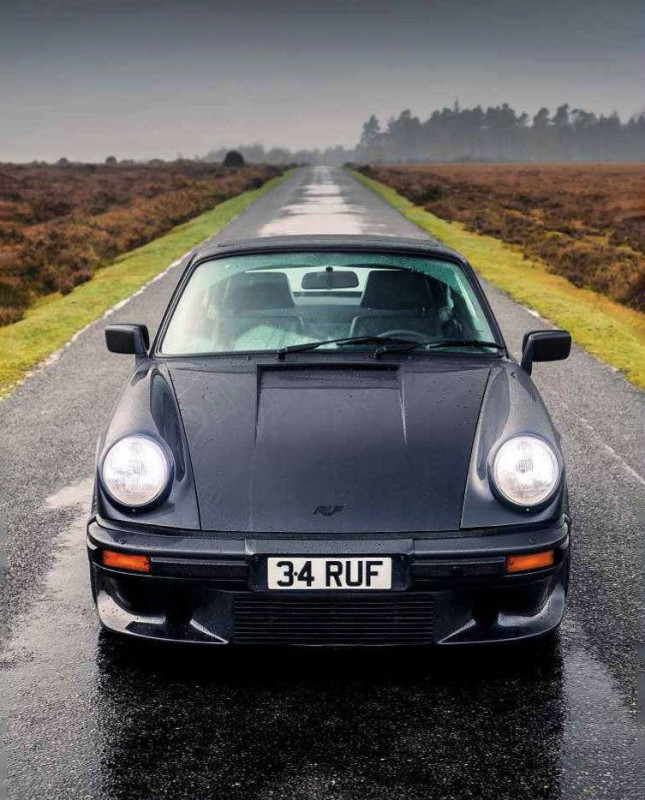
Today it lives in the South of England and, in the cold and drizzle of the New Forest, I’m pondering the appropriateness of such a day for driving such a monster. As that turbocharged flat-six rumbles and gasps into earshot, with a few crackles and pops for good measure, you can tell that this is no ordinary 911. It’s a car of immense presence thanks to its low and purposeful stance, but it’s also a car of surprising understatement. At first glance, BTR-1 is pretty subtle, but look closer and several small but significant details hint at this RUF’s outright performance.
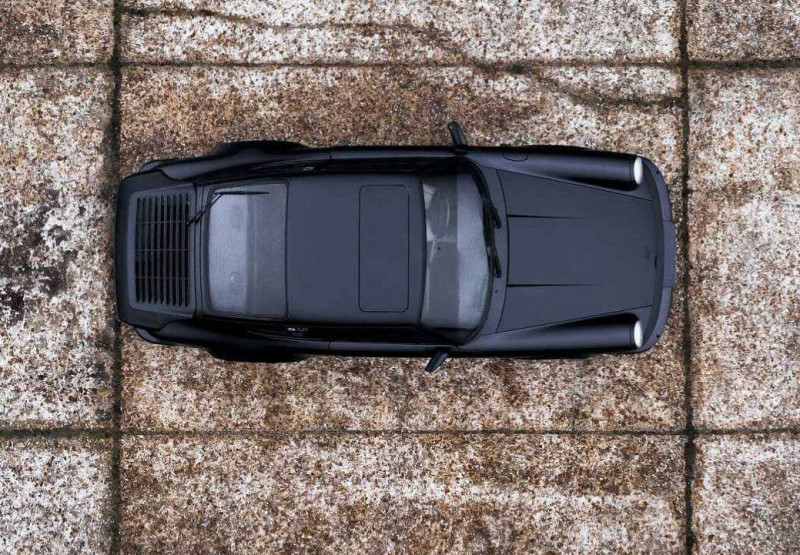
Unlike the contemporary 930 Turbo, RUF opted to utilise the standard narrow 911 bodyshell to build its ultimate road car — the wide-body option was said to knock at least 10mph off the top speed. The BTR got the full 930-spec whaletail spoiler, though, and hiding behind the deep front valance is an external oil-cooler, as well as a pair of brake cooling ducts. The super-wide 17in RUF wheels (with respective 8in and 9in footprints front and rear) fill the ’arches perfectly and, although Porsche s own 930 brake calipers are used up front, RUF opted to fit its own uprated design at the rear.
Lift up the weighty engine cover and, as with a typical 911, there’s actually very little to see. Dominating the show is a huge RUF intercooler sitting on top, which is 35% larger than the standard 930 item. Hiding below is a powerplant based on the 3.3-litre 930 motor, with capacity increased to 3.4 litres. New cams, pistons and a huge KKK turbocharger all helped push power and torque to 369bhp and 354lb ft. RUF was always conservative with its power figures, however, and following its most recent rebuild this car has recorded a yet more impressive 402bhp.
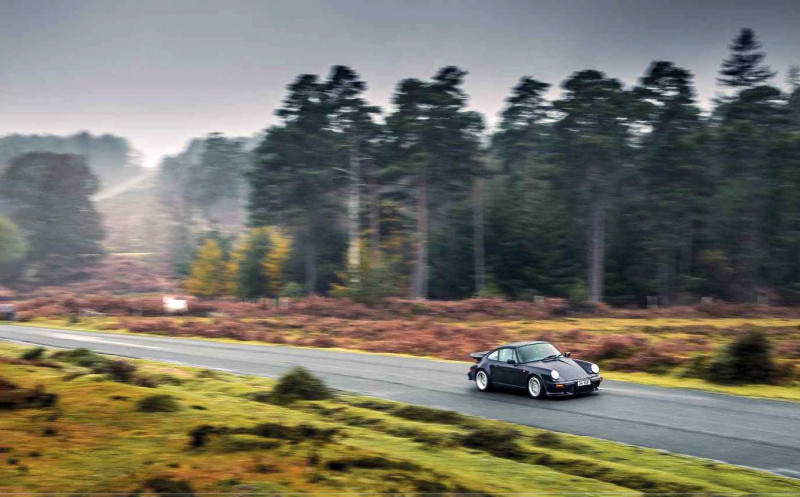
Peek under the rear bumper and you’ll see a bespoke exhaust system, with a large single exit on each side of the car. There’s also a smaller third exhaust on the left-hand side for the turbo wastegate. Perhaps more of a game-changer was the addition of a RUF-developed dog-leg five-speed gearbox, replacing the standard Porsche four-speeder about a year into its life.
Take a look inside, and again, the devil is in the detail. The blue leather seats are by Recaro, and there’s a subtle rollover bar behind the seats. The interior is in a lovely patinated condition and has the character of a car that has been well- used and enjoyed throughout its life. The RUF event stickers littering the rear window suggest that its previous owners have not been afraid to enjoy it on track, either. ‘We don’t know exactly, but it’s probably got more than 250,000 kilometres on it,’ chimes in dealer Charles Leith, who has brought the car along.
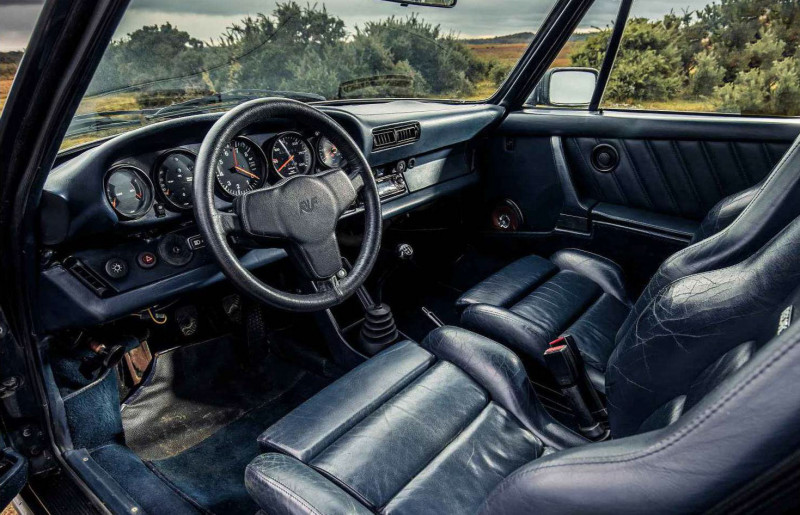
From the driver’s seat it’s pretty standard 911 Turbo, apart from three small details. There’s a large boost gauge in place of the standard clock, a gearknob displaying five ratios, and a strange metal knob down by my left shin… ‘Don’t touch that!’ Charles exclaims with a smile. ‘That’s the boost controller, currently locked off somewhere around 1-bar.’ He also pulls out a tote bag from the rear seat. Has Charles brought us some breakfast? Nope, within is possibly the most impressive bundle of documentation for any vehicle I’ve seen. Folders, paperwork and old magazines catalogue BTR-l’s entire history. And it’s rather a special history.
As a company, RUF traces its roots right back to 1939. Alois Ruf Snr opened his Auto RUF workshop in Pfaffenhausen’s Mindelheimer Strasse — the same street that the modem company resides in to this day. Thanks to the passion of the Ruf family, the company gained a fantastic reputation when it came to repairing and restoring Porsche cars.

Alois Snr died in 1975 and his son continued the legacy, tuning customers’ cars. By 1978, Ruf had launched his first fully enhanced Porsche model, the SCR. This was a lightened, stiffened and upgraded version of the underachieving 911 SC. Its slightly anaemic 3.0-litre engine was enlarged to 3.2 litres, and was further optimised to push power to 217bhp. Fitting the deep chin spoiler and whale tail rear wing gave it the unique RUF identity that’s become so recognisable since. Thank the 1970s fuel crisis: not only had it squeezed the 911’s sales, but also Porsche’s desire to offer more focused versions, so RUF was perfectly placed to fill the void.
In 1981, RUF earned manufacturer status from the German Automobile Manufacturers Association, which meant that it could build and homologate models from the ground up. With three 911 ‘bodies in white’ shipped from Stuttgart, RUF built an initial batch of BTRs in 1982, each gaining a unique RUF chassis number. This car was the very first completed, and was delivered to its first owner, Wolf Gregor, towards the end of the year. Gregor used it extensively over the next two years, making good use of its performance on derestricted autobahns. It returned to RUF for servicing, and the odd upgrade along the way.
How did this car end up being used by Road & Track? RUF’s development and test car should have been there, but it was almost destroyed in a crash the week before during a test event. Ruf was good friends with Gregor, and he persuaded him to drive the car to the test track. The company had managed to save the ‘new’ engine from the wrecked test car, and fitted it before the high-speed runs. Both Phil Hill and Paul Frere were highly complimentary about the BTR, not only excited by its speed and stability, but also the fact it was so tractable and easy to drive at lower speeds, too. Frere was also very impressed by the RUF gearbox.
After the test, Gregor drove the car home and continued to use it daily for many years, passing it to his brother Tilman in the later 1980s. It had covered over 200,000 kilometres by the time it came to a Brooks auction at Olympia, London, in 1997. The history confirmed three major engine refurbishments during that time, as well as a gearbox rebuild. It had also been restored by RUF in Germany in the winter of 1995: a full repaint, interior retrim and chassis refresh at a cost of over DM50,000 (around £20,000).
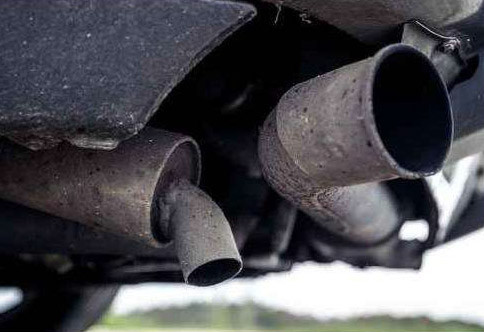
The next owner was Stephen Bloch of London, who placed a cheeky £12,000 bid on the RUF. He paid a total of £14,703 in the end, not much more than a standard SC would have cost at the time. According to an interview in the July 1998 issue of 911 and Porsche World, the first thing he did was book the car in at RUF UK’s Weybridge service centre for an inspection.
There, its identity as the first genuine RUF-manufactured car was confirmed. Although that was good news, it caused a few issues when getting the car registered in the UK, as RUF was not recognised here as a manufacturer. The simplest course of action, therefore, was to return the car to RUF and re-register it there, which required a trip back to Pfaffenhausen.
The history file shows that Bloch maintained the car with no regard to cost, lavishing more than £20,000 between 1997 and 2002. It received another engine rebuild in May 2002, just before being offered at the Bonhams Goodwood Festival auction in 2002.
Although it failed to sell there, the car’s current custodian managed to buy it from the same Bonhams auction a year later. Just like original owner Wolf Gregor, he pressed the RUF into regular service. The engine was given another full rebuild in 2007 by Porsche specialist Chris Mannion, consisting of a new crankshaft, replacement con-rods, new piston rings, new cam chains, six new injectors, a modified exhaust cross pipe, and all new consumable items. It was then set up by Bob Watson, with a print-out reporting a particularly healthy 402bhp and 440lb ft.
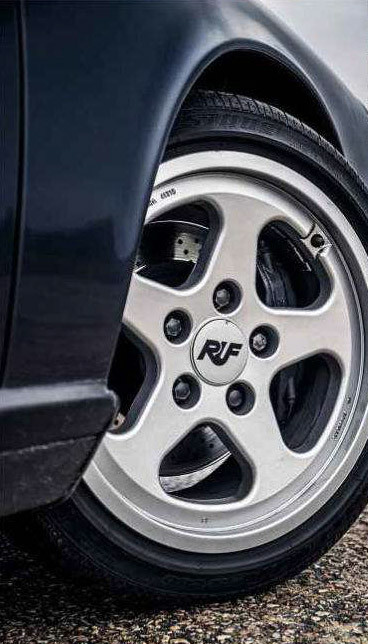
That, of course, is perfectly suited to the high-speed autobahn cruising it was designed to do, but I’m more excited to find out how intimidating it is on narrow, damp UK roads. The clutch requires a significant shove, while the surprisingly light flywheel demands a gentle touch on the accelerator. The chunky steering wheel also has serious heft behind it but, as soon as the speed gets above walking pace, you’re greeted by incredible feedback. It’s still hard work, even at higher speeds, but it’s worth the effort. There’s a dogleg first gear, and the stiff springing in the mechanism requires some force to overcome. You have to take your time with it but, once you get a feel for where everything is, it’s actually an intuitive box. Then there’s that engine.
It’s guttural, not exactly musical, but there’s a hard edge that isn’t present in a standard 930. Although it does a pretty good job of staying civilised at low speeds, this car wasn’t designed to trundle. It sounds moody at lower rpm and, despite the extra ratio in the RUF box, it’s still very much geared for the autobahn. Describing it as long-legged would be an understatement.
Thankfully the flat-six offers plenty of off-boost performance to keep you moving around town, and when the road opens up, that gargantuan KKK turbo wakes up. Very vocally! Once it’s started spooling, it’s a rush to the redline: 402bhp in something so light makes for an interesting recipe, stopping only just shy of unruly.
Just like any rear-engined Porsche Turbo, there’s no issue with traction although that’s certainly helped by the recent set of Bridgestone tyres. The roads are still a bit greasy, but it feels incredibly surefooted. You have to be determined to extract the most from the brakes, but the firm pedal offers magnificent stopping power and feel when you demand it. No surprise, of course, that the ride is unyielding over rougher sections and sharper ridges, and there’s never any doubt that the chassis has everything under control, but, while this is a car that demands plenty of respect, it’s not half as scary as I’d imagined it might be.
Just like his predecessors, BTR-l’s current owner has put plenty of miles on the car, even using it as a daily driver for some time: ‘I normally change cars every six months but I have owned this one for nearly 20 years. It has been just too good to part with. Before my retirement, if I was out visiting a client and could avoid tedious motorway driving, I would choose this car above the others in my collection. It is totally at home on A- and B-roads. Cross-country driving is where it thrills, yet it can be used “off boost” and still driven briskly to the shops. On track it is sublime. The rear end breaks away progressively and it has never spun in my hands. After a day’s use, I used to come away thinking “I should drive my RUF even more often.” I also like the fact that my clients didn’t regard it as flash.’
I find that last point particularly interesting, because it demonstrates that in many ways RUF is misunderstood. Sure, its cars can be specified in bright colours, but in the 1980s they offered everyday usability with supercar-slaying performance in what could be a relatively understated package. It’s thought that between 20 and 30 of these original BTRs were built, although, just to make things more complicated, a number of Porsches have also been converted to BTR spec by the RUF factory.
It might look, sound and to some extent drive like a Porsche — there’s no getting away from its roots — but the BTR is a different breed entirely. Using Porsche as abase was a natural step for a company so enthusiastic about the marque, but Alois Ruf took the 911 and made it his own. Over the years, RUF has built increasingly fast and often crazy cars, but it has mostly stuck to the formula that was perfected right here, first time out, with this original BTR.
Long may it continue.
THANKS TO Charles Leith, charlesleith.com, who is selling the car on behalf of its owner
TECHNICAL DATA 1984 RUF BTR-1 (as built)
- Engine Rear-mounted, air-cooled 3367cc flat-six, OHC per bank, KKK turbocharger, Bosch K-Jetronic fuel injection
- Max Power 369bhp @ 6000rpm
- Max Torque 354lb ft @ 4800rpm
- Transmission Five-speed manual transaxle, rear-wheel drive
- Steering Rack and pinion
- Suspension Front: MacPherson struts, lower wishbones, torsion bars, anti-roll bar. Rear: semi-trailing arms, torsion bars, telescopic dampers, anti-roll bar
- Brakes Vented discs, four-piston calipers
- Weight 1320kg
- Top speed 186.2mph
- 0-60mph 4.7sec
Above and left Ian view illustrates how slender BTR-1's body is, though stance is guaranteed by bespoke super-wide wheels; engine all go, no show; stickers bear witness to a lifetime of events attended.
Clockwise, from top Whaletail spoiler sits atop a tuned 3.3-litre turbocharged flat-six that pumps out 402bhp; extra exhaust for wastegate; lived-in interior is testament to long-term regular use.


